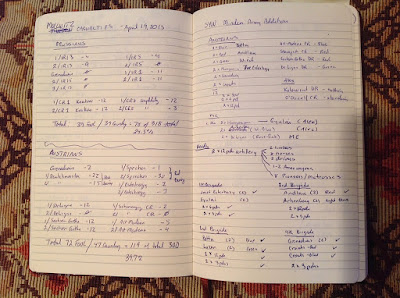 |
| Der Alte Fritz's painting table (definitely a SYW theme going on here) |
Here are a few pictures of my painting table in the cellar of Schloss Seewald. It looks like nothing special to speak of, but maybe it really does. Let's take a closer look:
CLICK ON ALL PICTURES ONCE OR TWICE TO ENLARGE THE VIEW
 |
| My current project: a squadron of 12 Austrian cuirassiers (Anhalt Zerbst Regiment) |
The picture above shows you what I am currently working on, a squadron of 12 Austrian cuirassiers, Minden Miniatures of course. I usually paint a dozen at a time, but this time I have broken the squadron down into two groups of six figures. I had been hitting a painting wall and decided that if I reduced the project into smaller pieces, then I could get my painting mojo up and get these guys finished.
 |
| In the middle background, the remains of a project that has been literally pushed to the back of the queue. |
The picture above depicts some of the Austrian equipment that I was working on a week or two ago. Behind the yellow Austrian 2-wheel ammo wagon is a Prussian 4-wheel wagon that has been sitting on the painting table for about 2 years. To the right side of the table, you can see a few samples and other one-off figures that I have painted over the last couple of years. To the right of the cannon model is General Knyphausen. Behind Knyphausen is a old Hinchcliffe one-piece casting of Napoleon. I really like the proportions of the Napoleon figure and want to paint him soon, for the fun of it. He has been in primer for about a decade, maybe longer.
Behind Napoleon one can see a Warfare Miniatures GNW Swede covered in blue paint and an RSM Croat reaching for his cartridge (he was painted by Dennis Smail of RSM). Behind the Croat is a French Napoleonic grenadier painted as one of the Paris Garde (red coat with green facings), a colorful unit that I want to paint someday. You can also see a couple of center company French in shakos also painted as the Paris Garde. These are all Elite Miniatures figures.
Moving on to the round wooden base, we see the Minden Zieten personality figure handing a message to another hussar. There is also a Legion d'Hainault French grenadier painted as a sort of Grenadier de France soldier. This was painted before the actual Grenadiers de France figures were added to the Minden range.
To the left of the Zieten stand is one solitary Esterhazy Hussar (Austrian SYW) that I painted as a sample figure prior to painting 24 of them on commission. I like the way that the horse turned out, so I saved him to use as a painting reference for future horses. Behind the Esterhazy hussar are two RSM SYW generals that will one day become Austrian generals. Behind the RSM generals are some Minden Prussian cuirassiers including Seydlitz. Next to Seydlitz is a cuirassier, back to the camera, that was painted by Frank Hammond (so I thought that I would save this figure for my own one off collection).
 |
| A collection of various wagons, cannon and limber that are gathering dust. |
We can see a number of wagons and cannons on this section of the painting table. I'm afraid that they have been parked here for about 2 years and are not likely to move off the dealer lot anytime soon. You can also see my copy of the Mollo SYW book. This was a rarity at one time, but I seem to have collected about 5 or 6 copies over the years. It is still a handy painting guide to have.
On the small round stand is an old RAFM 3-pounder that is now in Austrian service. A couple of RSM artillery crew are waiting for their new uniforms. Behind that are some Fife & Drum artillery pieces: red for French and unprimed Prussian 12-pounder. I seem to have enough Prussian 12-pounders these days, so there is no hurry to paint more.
Way back in the left corner is a Prussian cuirassier officer (RSM) painted by Bill Biles. Bill was my first figure painter when I first started in the hobby. He painted all of my Prussians while I learned to paint working on the Austrians. You can also see a stick of Suren Highlanders that I picked up at a bring and buy and plan to add to my Big Battalion Black Watch regiment.
The Minden French Marshal figure can be seen lurking among the paint pots. I hope that I can paint him one day, but without a French army, there is no sense of urgency on my part.
 |
| The shelf of One-Off Figures |
To the right of my painting area, are a couple of plastic drawers that contain paints. However, it seems that once a jar of paint goes into these drawers, they never see the light of day again.
On the top of the drawers is a motley collection of one off figures that I have painted over the past 10-15 years. I often try out samples of one figure to get an idea of how to paint it. You can see some Foundry and Crusader Prussians, a Perry Hessian Jager, a Suren British soldier at Fontenoy and a Dennis Mize fantasy warrior princess (Mize was one of the greatest figure sculptors that I have ever seen, in my opinion. His lifelike figures are amazing).
Well, that's a quick tour of my painting table. I hope that you enjoyed it. Leave comments if you want to ask any questions or just care to leave a comment. I enjoy reading the feedback.
h










































